While radio audiences continue to primarily engage with their favorite radio stations in the car, more people are streaming AM/FM and Internet radio, tuning in to digital radio, and downloading podcasts than ever before. Radio drives search even more than TV as listeners go online to learn more about what their favorite morning show and afternoon drive hosts or other on-air personalities are talking about.
From playlists and interviews to local news stories and interesting anecdotes, radio – both terrestrial and streaming – delivers a wide variety of content that can be accessed both over the air and through a station’s search-optimized website. Given that search plays a critical role in discoverability, that makes it so much more important to improve your radio station’s SEO on your WordPress website so that you can supply the content your audience is searching for.
We scoured the web for Radio Station SEO articles and noticed some gaps in the information presented online. We’ve created this comprehensive Radio Station SEO guide for you to read that will give you a good understanding of what is required to up the SEO game for your station.
Table of Contents
- Background
- Getting Started
- Expertise, Authority, and Trust
- SSL
- On-Page SEO
- Sitemaps
- Technical SEO and Page Speed Optimization
- How did page speed optimization become “a thing?”
- Why isn’t your radio station’s WordPress website fast in the first place?
- How do you do page speed optimization for WordPress?
- Choosing the right hosting provider
- Choosing a great page builder
- Choosing WordPress Plugins
- Measure your site’s page speed
- Common page speed optimizations
- Cumulative Layout Shift: What is it and how do I fix it?
- WordPress SEO Plugins
- The Final Piece: Radio Station Schema Markup
- Let’s Wrap!
Background
Historically, many radio stations focused their efforts on their over-the-air signal or local events as the primary touchpoints diving listener interaction and engagement. This has changed with the larger networks like U.S.-based iHeart Media going so far as adopting a new name to reflect a transition to and focus on digital. While larger radio networks continue the pivot to digital, more can be done by smaller independent networks, college and community radio broadcasters, and Internet broadcasters who primarily rely on social media to build and engage audiences.
Radio generates an average of 29% of all Google search activity and upwards of 33% during the morning drive. With so many listeners turning to search after hearing something on the radio, it tells us radio stations must search engine optimize their websites to ensure they are prepared for both text search and voice-activated search, which may become the primary method through which we search for radio-like content in the future.
If you haven’t done it already, it’s going to take a bit of effort to ensure your station’s website is search optimized so someone looking for a product mentioned in an ad or seeking information about a local event will find the information they are looking for on your station’s website – not your competitor’s.
Stations Not Focused On Search Lose Opportunities
Although the World Wide Web has now been with us for over three decades, many stations built websites and mobile apps primarily because they had to, underinvesting in them while relying on aggregators like TuneIn to distribute their streams. Doing so drives listeners into aggregator’s websites and mobile apps radio stations cannot control, which ultimately harms the station’s direct relationship with the listener.
Yes, listenership is obviously important, which is why aggregators are popular, but the value-add of search-optimized websites reinforces a station’s brand and can certainly drive additional revenue with the proper planning and website search engine optimization strategies.
Overreliance on aggregators and underinvestment in the marriage of their broadcast content with their own websites and mobile apps ceded both territory and revenue to aggregators who benefit from the lion’s share of cumulative revenue generated by its partner broadcaster’s streams, which they may only share with the larger networks under non-public agreements.
While possibly increasing listenership, a radio station on the TuneIn app is no longer competing with local audiences, but with thousands of stations. For local advertisers, expanding a station’s reach through apps doesn’t much matter because some in Los Angeles are not going to dine at a local advertiser’s restaurant in New York City. For radio stations, 3rd party app exposure does little to convert listeners into web users, limiting opportunities to engage and monetize audiences with eCommerce or other revenue-generating programs at the local level.
For one reason or another, radio station owners and program directors missed the opportunity to invite audiences to their own online experiences. Some broadcasters are starting to turn it around. They’re adapting by employing talent who not only sound good on the microphone but also have video appeal for social video broadcasting.
This is where search engine optimization comes into play. Now that a radio station’s websites broadcast more than just the audio stream, there’s a bit of work to do to make it easier for audiences to find and engage with content and programming. Radio station websites must be search optimized to ensure they rank for the content your listeners care about. Finding ways to bring audiences back to your radio station website will only serve to increase stickiness and traction inspiring loyalty and increasing revenue.
Getting Started
After reading blog posts like this one and this one, I found they were very good about telling you the why but not the how. With this post, I set out to craft a far more in-depth explanation with recommendations and clear action steps to help you make the on-page and technical SEO improvements that will amp up your Google page rank and drive more listeners to your radio station’s WordPress website.
Why WordPress?
Today, WordPress is far and away the leading CMS powering 43% of the world’s websites and used by radio stations, Internet broadcasters, and social audio moderators around the globe. There are many different open-source and proprietary content management systems you can use. I’ve seen some stations use SquareSpace or Wix, which are general website builders considered “easier” by some to use than WordPress, but that would not be accurate. Many lack radio-specific tools like our own Radio Station PRO plugin that works with WordPress exclusively.

Whenever something new comes along, those who rush to it profess it’s somehow “easier” or “better” than WordPress. That would be further from the truth. All content management systems come with a learning curve. They all have their complexities and nuances.
When we hear someone tell us this CMS is better than that CMS, it’s simply because they prefer it over something else either they’ve never really understood in the first place, they’re not comfortable with the user experience, or they might have a vested interest in promoting one over the other. It’s best to try out the ones you’re considering and understand the differences before you listen to members of each tribe profess why their CMS is the best.
Here at Radio Station PRO, we love WordPress. We believe in the platform and we’ve invested in it because it is the world’s most popular CMS.
Because WordPress is open-source, meaning the code is free to use by anyone under the GNU GPL (General Public License), a cottage industry of WordPress themes, plugins, and patterns (for those using recently introduced block-based publishing) has evolved to offer free, freemium (some features free and others unlocked with a subscription), or proprietary (all features unlocked with a subscription) solutions for website security, page speed optimization, SEO, events/ticketing, or even podcasting and broadcasting, which is part in parcel to what we do here at Radio Station PRO.
For example, let’s say you wanted to do the following:
- promote your Shows,
- promote your Hosts,
- publish news and commentary,
- broadcast your stream,
- podcast new programming or show archives,
- publish playlists,
- run contests and polls,
- promote events and sell tickets,
- sell products or digital downloads,
- seek donations or sell subscription access,
- build a mailing list,
- embed videos,
- connect to 3rd party storage services like Amazon S3, Google Drive, or Digital Ocean,
- manage your SEO,
- manage your advertising,
- host multiple sites as a network on a single domain,
- or, cross-post to social media sites.
You can easily do all of this with WordPress and, quite possibly, do it all without any developer assistance. WordPress gives radio stations, Internet streamers, and social audio moderators “no-code” solutions, which eliminate the cost of hiring developers and make it easier to build websites, even though those in-demand, highly skilled web developers are behind the scenes building these “no-code” alternatives to help you get the job done.
Is WordPress better for SEO?
In my mind, the short answer is…yes.
The long answer is, well, it depends. You can certainly rank with competing website builders. It’s even possible to rank with a basic HTML site and no CMS at all. However, Google’s search ranking algorithm is a black box made up of hundreds of data points that go into how one website is ranked against another when they are both delivering similar content
The things we generally know about search engines are that they rank sites based on on-site and technical variables. WordPress inherently has advantages over other platforms because of the way it was intentionally architected. You can optimize your site using plugins available for free, such as Autoptimize, Asset Cleanup: Page Speed Booster, and All in One SEO (freemium) or use paid plugins, All in One SEO PRO, WP Rocket, Yoast, or RankMath to help you in your SEO mission.
While not necessary, it is useful if this is new to you to first go through SEO strategy with an SEO consultant and cover all the bases before you start making critical decisions.
Backlinks – what are they and why do I need them?
A backlink is a hyperlink directing the site visitor browsing on a website to a page on another website. In SEO, backlinks are one of the most important measures of a site’s domain authority and page rank. The more links back to a site from authoritative and trusted sites the higher the domain authority and page rank of the target site. If hundreds of sites are pointing to your site, it’s like a referral or recommendation and if you accumulate lots of backlinks from trusted sites, your site rises because those sites referred back to yours.
This hyperlinked sentence is a backlink to a page on WP Beginner about backlinks.
High-quality backlinks from authoritative websites pass link juice (a common phrase used to describe the value assigned to links through backlinking) to target sites. The referral link from one site to another is important because it shows Google that the site being linked to is authoritative, trustworthy, and has in-depth expertise about a topic. Google wants to find the best answer to a search-query, so if lots of sites are pointing back to yours, then it stands to reason Google will lift your site in search engine results pages (aka SERPs).
Earlier in this post, I referenced sites by using backlinks in this post. If one of the links I included here is clicked, the link would take you to the target destination, but they don’t take you somewhere else on this site, they take you to external sites I may be citing or one’s that support my point of view. The more traffic to this post, which I purposely refer back to posts on other sites, the more authoritative this post becomes and the more link juice is passed across all of the posts I’ve included in the hope it contributes to their domain authority and page rank. Of course, there are times you might not want to pass link juice to another site. You may want to reference an article or a product and link to it but not pass any value to that post or page. For example, we can use no-follow to ensure we don’t pass link juice to paid links.
For those types of links, a company or individual paid for them as part of their digital marketing strategy. They’re not organic links that appear based on the author’s editorial judgment. In the WordPress link editor, I can then assign a “no follow” parameter to the link, which tells Google I do not want to pass link juice to the resulting page.
In WordPress, you would use your cursor to highlight the text you want to link to and then click the link icon in the text editor toolbar. Copy and paste or type the link into the text field provided. There’s an option to open the link in a new tab so that your site’s tab stays open in the browser. which makes it easier for the reader to return to your page in the open browser tab. You can then select options for no-follow, sponsored, and UGC designations.
If you’re using the WordPress Classic editor, you may not recognize the edit view in the image below, which is culled from the relatively recent block editor, which was referred to as the Gutenberg editor and is now commonly referred to as the block editor.
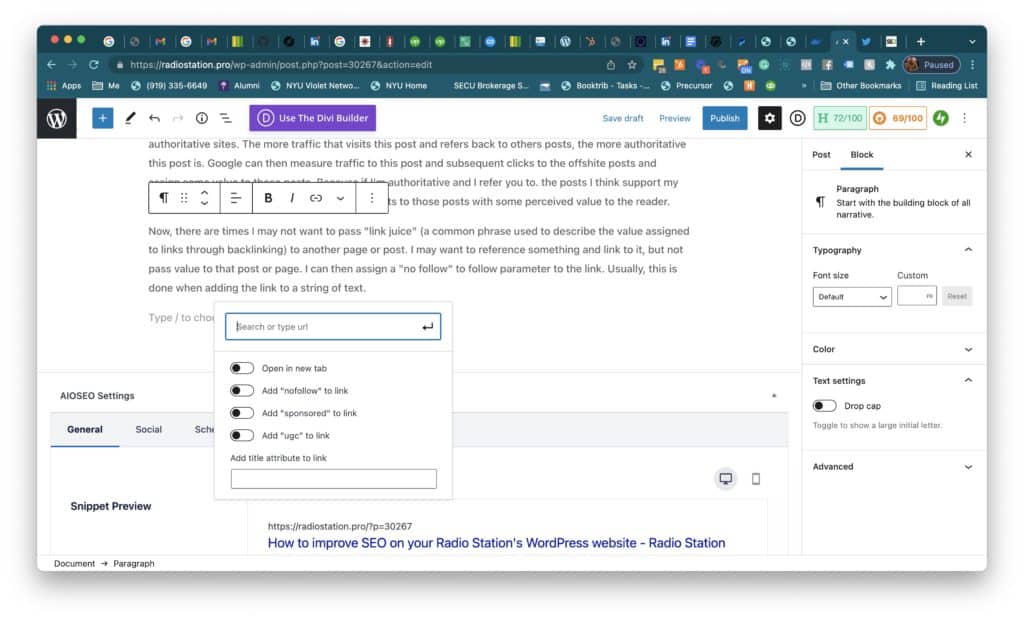
The link feature of the block editor also can designate a link as “sponsored” or “user-generated content.” According to this post, Google updated their search algorithm to better identify and de-list sites with spam links, so if you have qualified affiliate links you can wrap them in the “sponsored” element to link back to, for example, Amazon product links you may have generated through their affiliate program.
Here’s what All in One SEO says about UGC links:
“The ugc link attribute (rel=”ugc” ) allows website owners to tell Google and other search engine bots not to vote for that link. In other words, these are links that aren’t necessarily trusted or supported by the page’s author. And the UGC link attribute is a way to identify these links and tell Google about them.”
Pettersson, S. (2021, January 25). How to add UGC link attribute in WordPress (in just 2 clicks). All in One SEO Pack – Best WordPress SEO Plugin. Retrieved February 9, 2022, from https://aioseo.com/how-to-add-ugc-link-attribute-in-wordpress/
And, here’s what Search Engine Watch says about both sponsored and UGC links:
“Previously, the nofollow tag was used for both paid and user-generated links. … Currently, each of the three links (nollow, sponsored, and UGC) is used as a mere hint, not a direct ranking factor. While they may be crawled, they will not substantially impact rankings.”
Dyson, J. (2020, August 11). What google says about Nofollow, sponsored, and UGC links in 2020: Does it affect your seo rankings? Search Engine Watch. Retrieved February 9, 2022, from https://www.searchenginewatch.com/2020/07/24/what-google-says-about-nofollow-sponsored-and-ugc-links-in-2020-does-it-affect-your-seo-rankings/
How do I get backlinks?
One of the most difficult aspects of SEO is accumulating high-quality backlinks from trusted, authoritative sites to link back to your site. Let’s face it, you’ve got a new station that’s yet unproven, so why should anyone link back to your station’s website?
It can take some time to build trust with other sites and blogs that cover Internet radio, artists whose songs you play, or guests you have in the studio for on-the-air interviews. Asking them all to add a backlink to your station website is a trial in patience and perseverance. It’s not an automated process but a long slog that will succeed or fail based on your patience and persistence.
You always want to give a reason to backlink to your site. Maybe you’ve published a blog post with a YouTube video of an artist in heavy rotation. You might contact the artist’s manager and ask if they can publish a blog post about being added in rotation to your station or add ask to add your station’s logo to their home page mentioning the song was “heard on” your station and the logo is then linked back to your site.
You could also perform a Google search for a specific event in your local area that the station will be promoting and find blog posts or news articles related to that event. Contact the authors of the post or article and ask to refresh the post with a paragraph you provide about your station’s involvement with that event. Ask to include a link back to your site.
I receive emails all the time from SEO marketers asking if I can publish a post they create to my various blogs including links in the articles back to their client’s sites. It’s your mission to turn that strategy around and learn from what they’re doing so that it works for you.
Another method SEOs follow is to create posts for other websites and blogs. Start approaching them and post your content locally or regionally to publications. Ask them if you can include a link back to your station site. Site owners are always looking for content. Come up with a few great story ideas and start pitching!
Your success here depends on developing relationships with bloggers and other content publishers, so when you email them to inquire they know who you are and they are more likely to publish the content you produced because that’s one less piece of content they have to generate themselves.
Do social media posts generate “link juice?”
Social media posts do not offer link juice back to the sites people share on Facebook, Twitter, or any other social network. Going out and asking all of your friends to post a link to your site or a blog post on social media does not directly affect your page rank. However, the traffic generated from those posts and shares will benefit your site. And the more qualified, organic traffic, the higher your page rank anyway. Google does now consider your overall presence and brand equity on social media, but not from the social media posts themselves, as far as we know at the time this post was published.
Think about it; if Google allowed all links posted on social media to generate link juice, you’d see a massive increase in spam on the social networks with people trying to game the system to generate as many links back to their sites as possible. That would reduce the quality of posts on social media, which could have a detrimental effect on sites like Facebook and Twitter.
Read this SEM Rush article, Social Media SEO: 7 Ways Social Media Can Improve Your SEO Results, to better understand the relationship between Social Media SEO and page rank.
Do aggregators generate link juice?
Aggregators are another story.
What’s an aggregator? Defined by TechTarget.com: “A content aggregator is an individual, organization, or tool that collects web content and applications from different online sources for reuse.” Of course, many broadcasters want to be listed on the TuneIn app. The link back to your site in the TuneIn directory will carry some link juice because it’s a website and not a social media site, so shoot for listing your site with aggregators of radio content but don’t pay to be included on link farms; websites with no obvious connection to the broadcast industry.
When you join national organizations like the National Association of Broadcasters or state-specific organizations like the New Jersey Broadcasters Association, your station’s profile page on their sites will offer a backlink to your site. Yes, you may have to pay to join and get listed, but you’ll be able to join your industry organization for networking and business development purposes while seeing the secondary benefit of a high-quality backlink from those industry-specific organizations.
Do check first to make sure that these organizations link back without using no-follow or sponsored tags on your URL. If someone links back to your site with a no-follow designation on the link, that’s telling search engine’s not to follow the link to your site. Many sites that mention brands or products may set a no-follow rule simply to make sure that they are not contributing to the page rank of those they are linking to.
Who is backlinking to your site?
You can use tools like Ubersuggest, an SEO analysis system created by Neil Patel, a leading SEO and digital marketing strategist. A quick search on the site will show you who is linking to your site or your competitor’s sites. Ubbersuggest is a freemium service. It’s free for limited use but you’ll need to upgrade to unlock full results and additional features.
In the image below, we can see how many Backlinks are pointing to the Radio Station PRO website – 1,733 to date from 58 different referring domains.
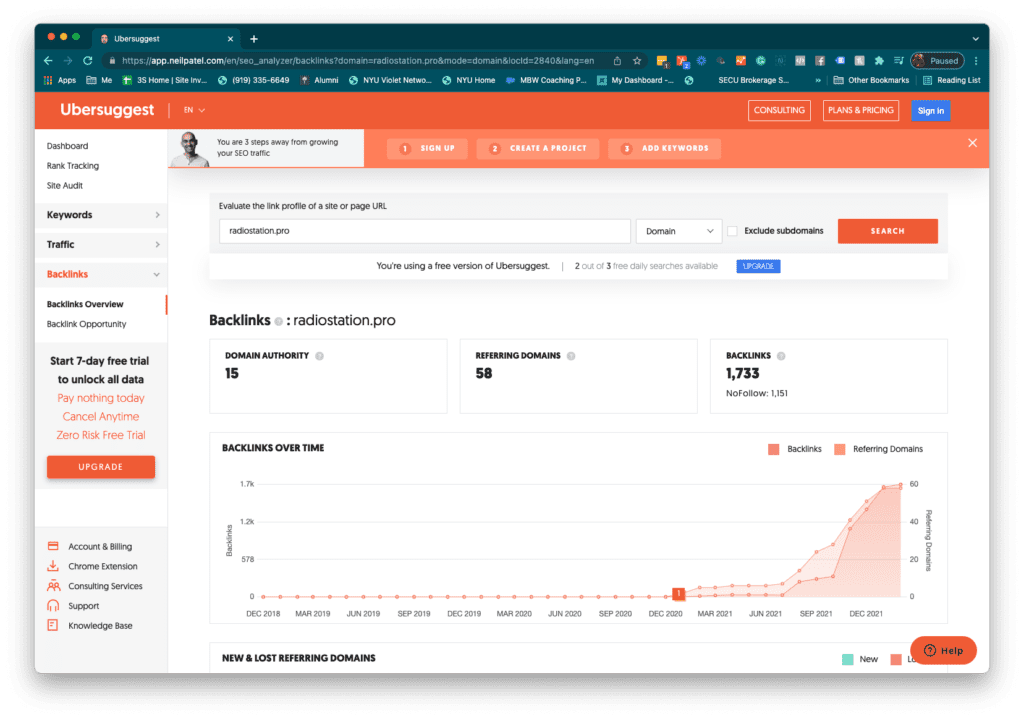
Ubersuggest will also show us the domain authority of referring domains. We can see that Radio Station PRO has far more lower-ranking domains than higher, but the site is relatively new. It was launched in August of 2021 and there hasn’t yet been a strong focus on building backlinks. The stats we’re seeing here are predominantly backlinks generated organically.
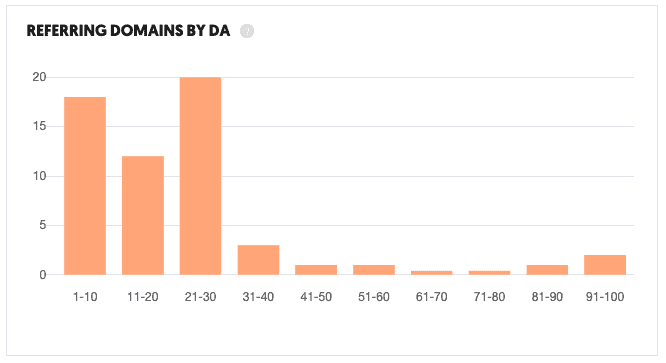
In the Ubersuggest Backlinks panel, the site lists all backlinks it has tracked to Radio Station PRO. This data will give you the information you need to reach out to some of these sites to forge a stronger relationship with them.
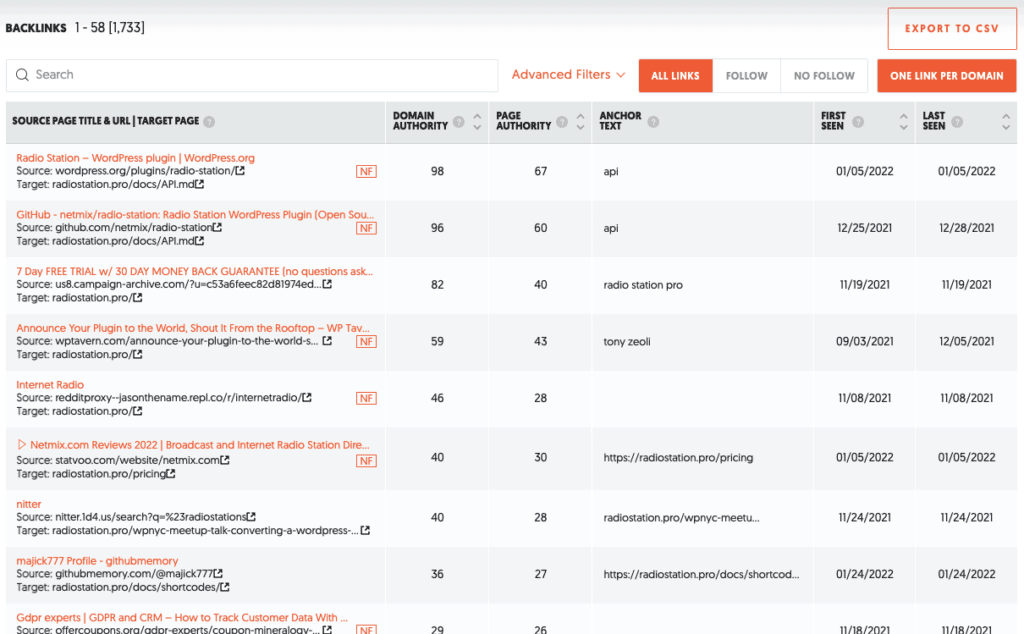
There are other SEO tools like MOZ, Screaming Frog, and SEM Rush that will also give you this similar data. Each charge a subscription fee.
Expertise, Authority, and Trust
Search engines like Google or Bing are crawling the Internet to read all the world’s web pages and store cues to content relative to a search term someone might type into a search engine. The search engine seeks to return the most authoritative, in-depth, high-quality content to ensure that the user submitting the query is returned links to the best information available on the Internet that answers the query, so the content on your website must meet the highest standards employed by search engine companies like Google and the algorithms they create in order for your site pages to rank.
Search providers often tweak their algorithms to improve upon delivering the best search results possible to users, and in the process, mitigate or eliminate black hat SEO methods that some nefarious SEO actors try to employ to game the system.
In August 2018, Google released its E-A-T update, which stands for Expertise, Authority, and Trust. This update looks at a number of factors to determine the quality of your content to rank the content higher or lower than similar posts and pages. Google is going to rank a page or a post on expertise. For example, is this content exhibiting expertise or knowledge in the subject at hand that is in-depth and rich with information relevant to the search query?
Google is also going to look at the author of the content and it might favor those who are well regarded and have achieved a level of popularity on social media. Do your site’s authors have well-crafted profiles on social media with lots of followers? Are their blog posts or social media posts authoritative and contributing to the greater Internet body of knowledge? Are they expressing expertise in the subject matter?
Neil Patel is one of the leading experts in digital marketing and he frequently publishes content that many people like, share and follow on social media. He’s gradually become the expert in the room on subjects pertaining to digital media marketing. Seth Resler is a leading blogger and digital strategist in the radio industry. They both got to where they are by being prolific bloggers sharing actionable insights for you to learn from. The content on their pages and posts is read and shared widely, helping them cement their industry insider positions while generating opportunities they may not have had otherwise.
The more high-quality and relevant content we produce and publish, the more expertise and authority we accumulate, and the more Google sees the value we are contributing to the body of Internet knowledge. This sort of goes hand-in-hand with social media networks that enforce a “real name” strategy. If you’re not using your real name and relying on a pseudonym, is that an effective strategy to build the value of your personal brand? Probably not.
Sure, there are times when it’s impossible to use a real name. It may be a post by a group in an organization and not an individual. Or, the Host or DJ may be using a catchy trade name. I used DJ Tony Z, but now everything I do is as Tony Zeoli to build an authoritative voice online under one unique identity so Google can crawl all the content I produce using my real name on blogs and social networks, then relate it back to me from as far back as their databases track through to today.
Radio Station PRO provides radio stations and Internet broadcasters with host and producer profile pages (see an example here), so blog posts can be published by Hosts and Producers and assigned to their profile pages. It is critical to fill in a Host or Producer page with rich content – text, images, audio, and video so that audiences can uncover more information about their favorite on-air talent or learn more about the people behind the scenes creating the content they care about.
Many WordPress themes include the author bio at the end of every post. At first, it was cosmetic and good practice to include, but with Google focused on E.A.T., it has become even more important to include the author bio and link to the author profile page, which is why a plugin like Simple Author Box Pro has become a must-have for your radio station website. Not only does it display the profile on a post, but it can include social media buttons and related posts by the author or attribute to guest authors and multiple authors on a post.
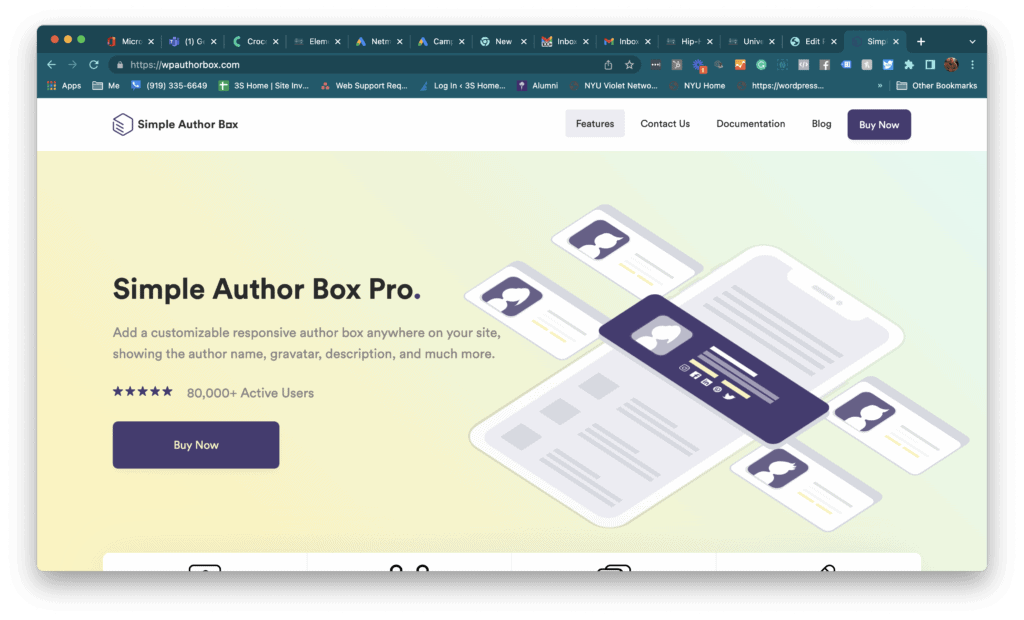
Page builders like Elementgor also include an Author Box widget. You have many options. Look to your page builder first to set the Author Box, but if it doesn’t exist, then Author Box Pro would be a good solution.
Lastly, there’s trust. There’s a lot of misinformation out there on the open web. Google is looking for content it can trust, which is going to be valuable to the person performing a search. The more expert, authoritative content you publish, the more you build trust. Of course, Expertise and Authority have much to do with Trust, so we want to combine those three elements on our sites and take advantage of the E-A-T. algorithm to provide exceptional results to answer a search query.
SSL
A key aspect of E-A-T is SSL or secure socket layer encryption. Google has long pressed for webmasters to switch from the HTTP to the HTTPS protocol in order to better secure data being transferred between websites, as well as for authentication to confirm you are visiting the intended website.
What is an SSL Certificate?
SSL is secure certificate that offers three layers of protection: encryption, which means that all data sent between a browser (client) and a website (server) are encrypted so that even if data are stolen or intercepted a hacker won’t be able to decrypt them; data integrity, which guarantees that your data cannot be modified or corrupted during transfer without being detected; and authentication, which verifies whether you are actually communicating with the intended website. To make sure your communications are safe, you can look for a special green padlock in your browser’s URL bar that indicates whether or not a website is secure.
Viktoria, and Dmytro. “How SSL Works and Why You Should Secure Your Site with HTTPS.” Custom Software Development and Consulting Company | RubyGarage, RubyGarage, 23 Mar. 2017, https://rubygarage.org/blog/http-vs-https-secure-your-site-with-ssl.
How do I get an SSL certificate for my Radio station website?
It is imperative all sites are secured with SSL. In the post, SSL certificates had a cost to them, but now you can get one for free unless you want the secure lock in your browser URL address bar to display your company information. Check with your WebHost for free Let’s Encrypt certificates for each of your hosted domains.
You can pay for an SSL certificate through companies like Comodo, which will issue a certificate for you after you submit to a verification process, including a background check.
We use Cloudflare as our DNS provider and secure our sites with their free SSL certificates through the free tier of that service.
For more in-depth information on WordPress and SSL, please read this Cloudways post about WordPress SSL.
On-Page SEO
This aspect of search engine optimization helps to drive visitors to a website by optimizing the content on your website’s pages and blog posts so they are filtered into the results of the user’s search query. It has everything to do with the keywords being used within the meta values and body content; how relevant the content is to the subject, as well as the expertise, authority, and trust of the author of the content. Of course, we always need to start with a topic.
Here’s an example. Let’s say the pop music artist, Ed Sheeran, is starting a new tour. Depending on a variety of factors including when the tour was announced, the title of your post might answer this question:
When does Ed Sheeran go on tour?
You might be wondering, how do you know the question to answer? While you could use Ubersuggest or other costly SEO tools to research the key phrase, one of the easiest ways to find popular keywords in response to a question is to simply learn from a Google search what the popular search term is for a particular topic.
Simply launch Google in your browser. In the URL bar, type out the question. Before you hit the return key, Google will show you a mix of results in the live-type search result called auto-complete. You can see what the most popular search terms being used are without having to pay a 3rd party for important market research.

Once you’ve uncovered the search term, hit the return key to complete the search.
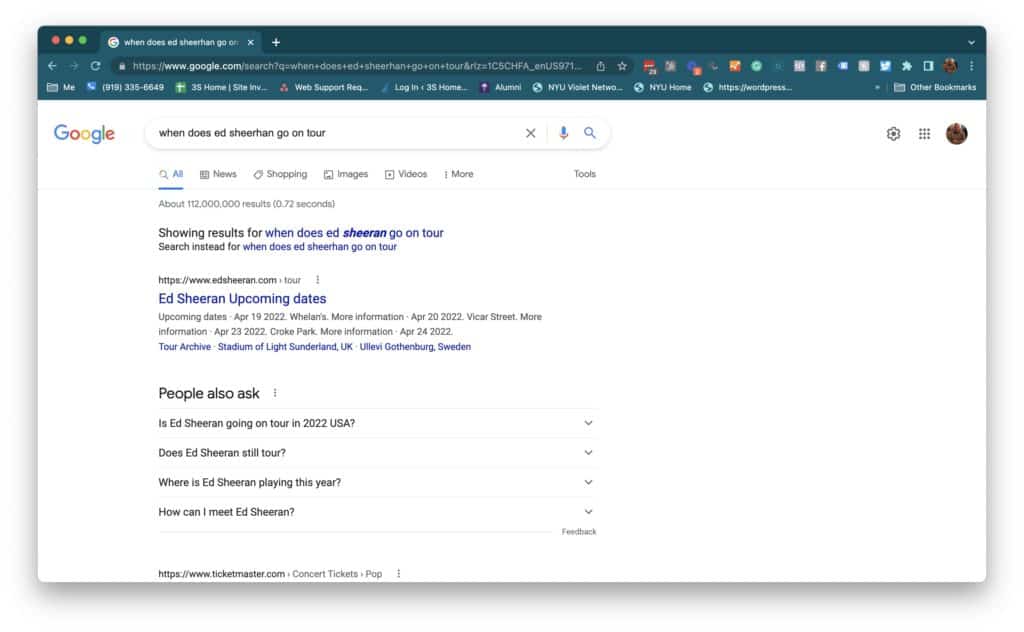
‘The first result is Ed Sheeran’s own website, of course, and the post title is Ed Sheeran Upcoming dates.
While the first result could have been from a ticket broker or music blog announcing the tour dates, Ed Sheeran’s own tour page is certainly the most authoritative voice of all things regarding Ed Sheeran’s upcoming dates. The Post title and Meta description, as well as the page itself, give Google the best possible content to return.
In the screenshot, you can see the domain name, the H1 site title, as well as the menu nav bar, and the tour dates themselves. All of this content gives Google a pretty good reason to return Sheerhan’s own site as the first result on the SERP (search engine results page).
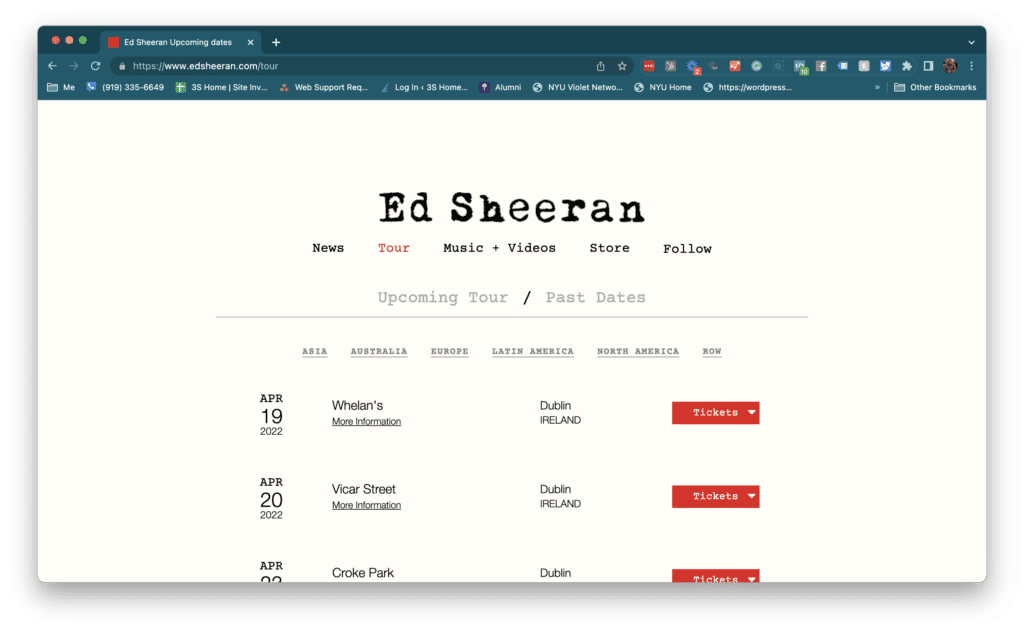
When viewing the source code of the website, we can validate the keyword: “Ed Sheeran.” It’s the H1 Title. Nothing else but his name appears, but given that the domain name is also edsheerhan.com, they both combine to confer authority and trust. Of course, all website traffic over the course of the website’s time on the web plays a role in addition to other factors.
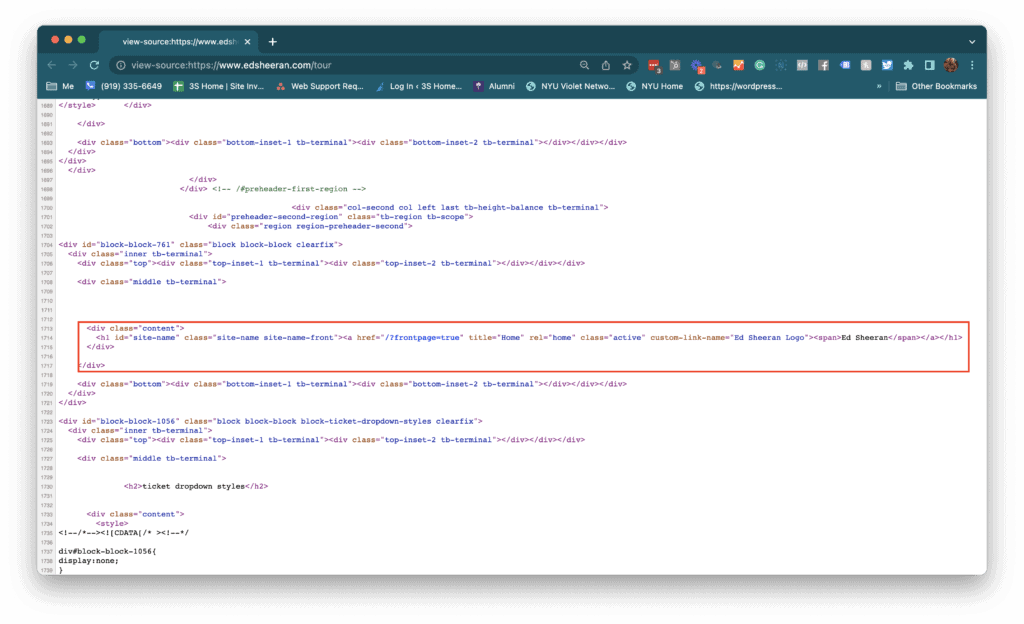
Let’s look at the site’s meta description to see if that matches what is returned in the Google SERP.


We can see in the code that the meta description is “The Official site of Ed Sheeran.” That certainly tells Google something and a large number of backlinks to the site confirm that this is the official site of the artist. But why doesn’t Google use that text as the meta description returned in the SERP listing.? Because Google can decide what it wants to feature for a meta description, even if you tell it otherwise with an SEO plugin like All in One SEO, RankMath, or Yoast.
Today, most tour information on major ticket brokers or artist sites is wrapped in some type of data tag. In this case, all tour dates have a property associated with them using DCMI (Dublin Core Meta Data Initiative).

The metadata identifier helps Google understand what the content is and therefore Google returns those dates as the meta description, prioritizing that information over the description in the meta description field.
Who adds this layer of DCMI? If you’re building a site from scratch, you want your developer to include DCMI wrapped around a data object, but generally speaking, if using WordPress, then a plugin might add that for you behind the scenes.
We’ll get into how to manipulate the post title and meta description so that Google displays exactly what you want in a SERP result using an SEO plugin a bit later in this post but for now, we’ve addressed the post title and meta description. What about the content itself? That is critically important.
In the case of the Ed Sheehan site, The tour page only lists available dates and purchase buttons to buy tickets. There isn’t much in the way of written content, but because it’s coming from Ed Sheehan’s own site, it’s going to rank higher than Ticketmaster simply because it’s coming from the more authoritative website. Ticketmaster, while extremely popular, is not the artist himself. Google is going to return the most authoritative result – Ed Sheehan’s own website.
So what are other types of content you can add to a page or post that will help with your on-page SEO? The first and most important for radio stations is your Show schedule. It’s critical to provide your audience with a way to click into their favorite programming or find new shows to listen to. That means having a comprehensive show schedule with fully formed show pages, like this Calendar view from our Radio Station PRO plugin (view the Calendar demo).

In Radio Station (free) and Radio Station PRO, we offer a Show Scheduling system. Creating a Show spawns a Show page with associated metadata about the show, including:
- days and times (free/pro)
- timezone (free)
- timezone switching (pro)
- Patreon button
- social links (pro)
- genres (free/pro)
- stream link (free/pro)
- hosts (free)
- producers (pro)
- full description of the show
- featured image
- show avatar
- playlists (free/pro)
- related posts (free/pro)
- Hosts (free)
- Team (pro)
- Episodes (pro)
Below is an example of a Radio Station PRO Show page template.
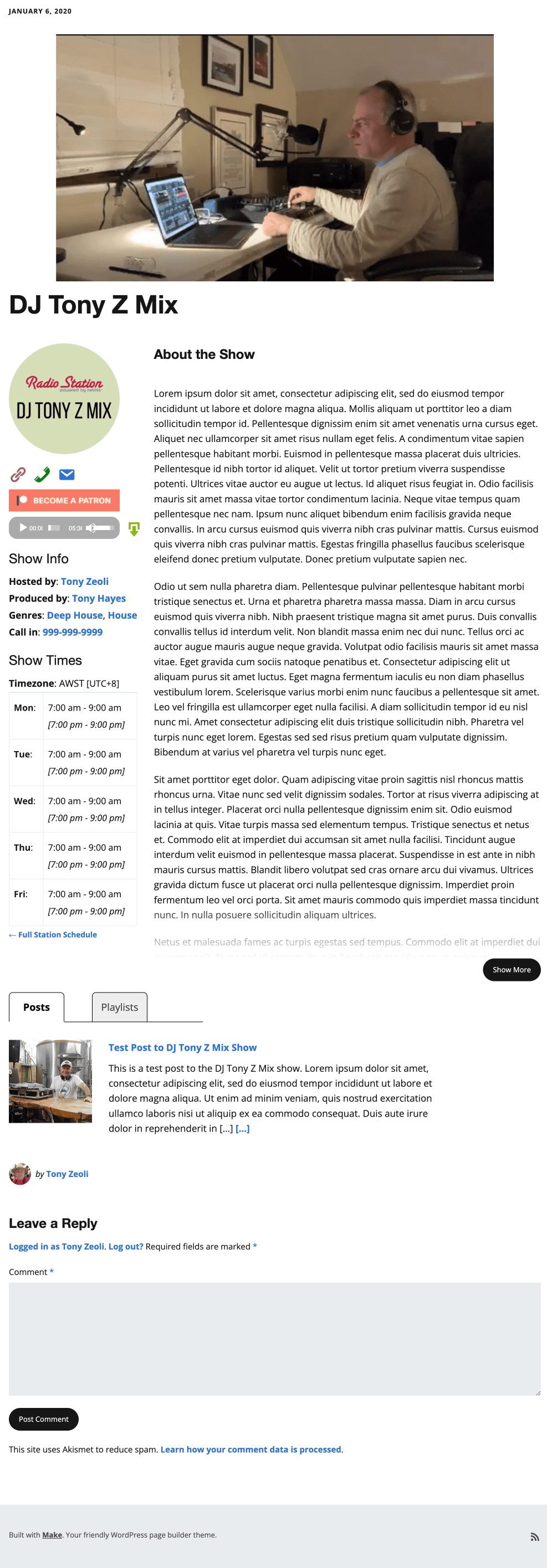
The clear benefit to structured Show pages like the one we’ve included in Radio Station is the search engine optimization of a Show itself. When listeners are looking for Shows, they are going to find those Shows in a Google search. But if those Shows are created using regular WordPress pages, the post type of Pages does not include all of the relevant Show metadata attached to the Shows post type. That’s why Radio Station PRO is so critically important to any Internet or broadcast radio station today.
When we went out to survey stations using our Radio Station plugin on their websites, we found a lot of stations use the schedule, but what they don’t do is fill in the resulting Show page. We found Shows with no descriptions, no associated hosts, no playlists, and no images. Those are serious omissions not only for Google search but also for listeners who will wonder: why have a website if the content I’m looking for is not there? Stations that do provide a rich content experience will attract and retain listeners who will likely come back to the station’s website. If not, they’ll feel it’s a poor user experience and not return, therefore increasing your bounce rate and decreasing your time spent on site metrics.
Remember, creating stickiness to build return visits and time spent on site is part and parcel of the Google E-A-T philosophy. The more time users spend on your site reduces your bounce rate, the metric search engines use to track the time visitors stay on your site and how fast they “bounce” out. A low bounce rate positively contributes to your SEO bottom line.
Sitemaps
You may have heard the term, sitemap, in your WordPress work. Sitemaps are part of SEO only in the sense that they are a living document of all of the links that exist on your website – from pages and posts to images and other media, we generate a site map and register those sitemaps with search engines like Google, Bing, Yandex (Russia), and Baidu (China), to help those search engines more effectively crawl our websites while providing important analytics regarding the keywords and position of those keywords that drove traffic to your site. When you register a site map with Google, Bing, and others, those systems will track the pages that are being crawled and will notify you if they see any issues or errors with a page or range of pages.
While sitemaps are useful to search engines to help them crawl your website more efficiently and provide analytics and reporting on search terms and broken links that result in their systems not being able to crawl your site efficiently, they do not provide any “juice” to boost your site’s ranking but by indexing your site more efficiently and sharing those links back with Google search, Google can then better provide more targeted results to a user performing an online search. Ultimately that is better for your SEO, but there is no direct 1:1 correlation in the sense that Google uses this information to boost your page rank. It’s boosted inherently so your site is more, not less, searchable.
There are a number of SEO plugins for WordPress like All in One SEO PRO (and FREE), Rank Math, and Yoast among others that generate sitemaps once you install them. Some are free, others are freemium, and Yoast is only available as a paid version. You can then register the URL of your site map with each individual service. No, you don’t have to create a site map yourself. As you add and remove pages and media, your site map will be automatically updated with the resulting URLs to those links and assets.
Google, Bing, Yandex, and Baidu accept sitemap submissions, but Baidu requires a China-issued phone number to register an account. If that’s important to you, you’ll figure it out, but if most of your traffic is from the U.S. Canada, and Europe, I wouldn’t worry about Baidu unless marketing to Chinese language speakers is critical. I haven’t yet figured out how to get a Chinese phone number but am sure it’s possible.
Technical SEO and Page Speed Optimization
Now we’re getting into an aspect of SEO that has grown into its own cottage industry complete with consultants, developers, plugins, and websites or blogs dedicated to page speed optimization. Sure, SEO has always had its ups and downs. Keyword optimization is hit or miss, backlinks are difficult to secure, and knowing what content wins is like playing the slots in Vegas. Now, add page speed optimization to the equation and the real fun begins!
Just when you thought you had a handle on things, you learn your site is scoring an F rating on GT Metrix and is running in the red with a GPSI score of a morbid 20 on mobile and maybe 32 for desktop when those numbers should be in the green above 80 for both.
You can spend hours, days, or even weeks on page speed optimization to get it right because you might remember to do one thing, but forget to do another. There are a number of plugins that handle page speed optimization for WordPress, but sometimes you have to ask questions in support forums and wait hours or days for a response. With Google’s recent measurement of CLS (cumulative layout shift), it could take 30-days (as of this writing, but that could change) to see if recommended changes helped overcome the errors listed on Google’s pagespeed.web.dev portal for your domain.
Of course, once you get it right, bingo! – you’ve hit the proverbial jackpot and if so you may see your site’s posts and pages start to rank higher than your competition.
How did page speed optimization become “a thing?”
As Google has evolved, so haven’t those who want to game the system to try to manipulate search results with black hat SEO techniques. That means Google has to stay one step ahead of nefarious actors working feverishly to beat out legitimate SEO results.
Once Google releases new algorithm updates, the race is on to find ways to game the system. Google and other search engines realized long ago they must constantly evolve and find creative ways to protect search results or risk tarnishing their brand because if you can’t be confident in the results, then you’ll go elsewhere..
One way to do this is to filter out sites that are slow, because how many black hat SEOs spend time on performance rather than keywords and content? Scammers need to move fast and spending time on performance disrupts their ability to focus on another aspect of SEO that has worked for them in the past. Adding page speed as a measurement to the SEO mix forces black hat SEOs to confront another hurdle to game the system. When combined with all aspects of SEO, that makes it much harder to do because page speed optimization is not as easily implemented as keywords and content.
Preventing black hat SEOs from gaming the system is not the only reason for page speed optimization. There is another major reason for Google’s insistence that your site performs well.
When you used Google, the company doesn’t want to send you to slow, clunky websites because it tarnishes the Google brand. Google wants to send you to fast, speedy websites because it knows if it can impress you with high-quality search results that you don’t have to wait to load – especially on mobile devices. If you look at your website analytics, you might find that over 50% of your traffic is from users visiting your site on mobile devices. Mostly phones but often tablets too. According to this Oberlo blog post, 63% of all searches through Google originate on mobile devices.
Think about how often you get frustrated waiting in line for service. Maybe you’re waiting in line somewhere and the line is slow. You look across the street and see there’s another establishment without a line or a wait, so you jump out of line and go where there is no wait. Well, the same rings true for search engines.
While Google and others may return a number of results for you to click on, once you take action, if the site is slow and takes too long to load, you start to wonder why Google is sending you to sites that underperform. If Google keeps sending you to slow websites, you’re going to start wondering. why do you use Google in the first place? You might start to think Bing or Duck Duck Go will show you better, faster results, which is the last thing Google wants and that’s why page speed is so important.
Page speed optimization contributes to your site’s rank in addition to all the other SEO techniques you’re using. This means less reliance on large graphics, video, and interactives and a focus on fast-loading text and CSS. If your site loads fast, Google will acknowledge the efforts you’re making to improve load times on your site.
Of course, the content will always be the KING! Whoever has the best, most trafficked answer to a search query is going to win the SEO game, but site speed and performance play into the overall ranking your site receives, and is why it’s an important aspect to address along with your on-page SEO efforts.
Why isn’t your radio station’s WordPress website fast in the first place?
If you’re using a base installation of WordPress hosting with a well-regarded hosting provider and you’re running a standard WordPress theme that ships with WordPress with maybe one image on each page and no plugins, you’re site is going to probably perform pretty well out of the gate. However, in today’s WordPress marketplace, we design highly-styled websites with page builders or 3rd party themes and plugins that use a lot of CSS and javascript to make our websites do things like force the site header to be sticky, change slider content dynamically, or hide content behind a selection that is revealed once the user clicks on a button or a link.
Plugins, themes, and page builders introduce functionality that is not in WordPress core and rely on loading a lot of javascript and CSS, as well as calling on the database to return options setting used by those themes, plugins, and page builders. The site also has to call the database and return content to the requested page. Large, uncompressed images can take time to load, especially when a visitor to your site is on a slow connection or older mobile device. If your radio station website has to load a stream, that can cause an impact on page speed if the stream wants to buffer and load before the site’s pages do.
There are a lot of variables to consider when choosing a hosting company, a page builder, or the themes and plugins we need to use to deliver impressive response times. That’s why you have to ask around and do your research before you commit to a design and development path. While there are performance metrics out there measuring the speed of page builders like Oxygen, Elementor, and Divi, which are some of the most popular page builders on the market, your site still may experience slowness because of the hosting provider or a plugin you don’t realize is slowing down your site.
it takes a fair amount of research, reading blogs like Online Media Masters, or following the forums of plugins that deal with page speed optimization to truly understand how to master it. Even if you think you’ve got all the bases covered, sometimes a theme or page builder will introduce something that you just cannot account for and solve, so you need to be very careful and somewhat skeptical about what these page builders tell you.
For example, for one site I’m working on for a client outside of Radio Station PRO, the page builder introduced something that I just can’t solve because it’s baked into the page builder. I may never get to a GT Metrix score of A or a GPSI score of 90+ simply because that one issue is preventing me from getting there. But the client can’t tear down the entire site and rebuild with another page builder because their budget may not allow for it.
How do you do page speed optimization for WordPress?
Page speed optimization is tricky. It’s one of those things that is both an art and science. it can be quite nuanced but also strictly implemented. Once you get it right, you’ll achieve positive outcomes for your radio station’s website. Better ranking in search translates into more visitors, which turns into more opportunities to connect with your local, regional, national, or even global audience and monetize that site traffic.
While page speed optimization is seemingly complex, you don’t have to be a developer to learn how to optimize your site to load fast. But you’ll need to make some critical decisions before you start down the road and those are:
Choosing the right hosting provider
We work exclusively with WP Engine and highly recommend their hosting service, but it might not be exactly the right fit for you. They can host your website, but they don’t offer stream hosting, so you may need to find another service for that aspect of your radio station website. Tom from Online Media Masters recommends Cloudways, but just be forewarned, it’s not as easy to set up out of the gate. I signed up for an account just to log in and check it out and it was a bit confusing to a novice. I’m sure it’s fine if you want to spend some time with it. And, it seems to be a little cheaper.
Choosing a great page builder
We recommend sticking with the major page builders like Oxygen, Elementor, or Elegant Theme page builder, Divi, and using the base or combined page builder + theme that comes with those platforms. We don’t recommend purchasing radio station themes from Theme Forest. While they may look sleek and have some of the components you think you need, they’re built and maintained by smaller companies with fewer resources and they may ship their themes with page builders anyway – maybe the page builder you don’t want. You then buy the theme and have to license the page builder the following year once your combined licenses expire, which they never tell you upfront.
By the way, in case you weren’t thinking this way, buying a well-vetted page builder and deploying it along with our own Radio Station PRO plugin will give you a similar experience. Plus, you’ll always be able to utilize updates to the page builder and the plugin, reducing your reliance on a third party for an integrated theme with plugin features that may box you in and not give you the flexibility you need to develop your website over the long term.
Their support may be slower than the major page builders and if you want to ever change the theme itself or the page builder used to build the theme, you may lose access to data stored by the theme and there’s no way to easily migrate it to a new platform. Choosing your page builder before choosing a theme is probably a better idea than choosing a theme and getting stuck with the page builder that ships with the theme; one that you didn’t want in the first place.
Choosing WordPress Plugins
People love free stuff. Heck, I love free stuff too! Here at Radio Station PRO, we understand that free is a great way to connect with users, so though we even offer a free version of Radio Station, the overarching problem with free is that you are limited to the features in the free version that don’t exist in a PRO version. And, you don’t get priority support. Sometimes you have to wait days for an answer instead of getting in the VIP queue. You have to consider what you’re trying to do and whether a PRO version offers the solutions and support you need that fits your budget.
I pay for a lot of the plugins we use on the Radio Station PRO and Netmix WordPress sites, mainly because we know they are from quality plugin developers who have been around for some time time. By paying for their solutions, we are contributing to their success and they are contributing to ours. If we weren’t able to contact their support teams for immediate solutions, it would be harder to run our business.
For example, we use Gravity Forms as our form builder. We could use Contact Form 7, but Gravity Forms provides all of the features we need and then some, while we’d have to install two, three, or even four different plugins to use with Contact Form 7 just to get it to work the way we need it to.
Gravity Forms also has a host of integrations that work out of the gate. One is with MailChimp, our email newsletter provider. That means I can reduce my reliance on yet another plugin to do something Gravity Forms does inherently. Consolidating plugin tasks is important to use fewer system resources and reduce reliance on too many 3rd party developers.
Of course, we’d love for you to try Radio Station PRO. You can sign up for our 7-day free trial to see if using a plugin with a page builder is right for your station. Use RSPRO30 to take 30% OFF the purchase price of Radio Station PRO at checkout when you start your free trial.
However, that’s not to say there aren’t free or freemium plugins you should choose. There are and they can be very good. One of our favorites is Autoptimize. It’s a great page speed optimization plugin with terrific support, but it feeds into other paid plugins and services like CriticalCSS.com and ShortPixel.com, which perform various aspects of page speed optimization not included in the Autoptimize plugin.
Measure your site’s page speed
Whether you’re developing a new radio station website or you want to improve the page speed of your current site, you’ll need to measure your site’s page speed. You do this with a few popular websites SEOs use to generate a rating and resulting report indicating how fast your site is and what you might need to do to resolve uncovered issues.
Three common websites are:
- GT Metrix
- Google’s pagespeed.web.dev
- Pingdom
Here’s an example report from GT Metrix for our Radio Station PRO site you’re looking at right now. It shows we have a solid A score and the site is loading in the green at 635ms, despite the fact that we load a background video on the home page.
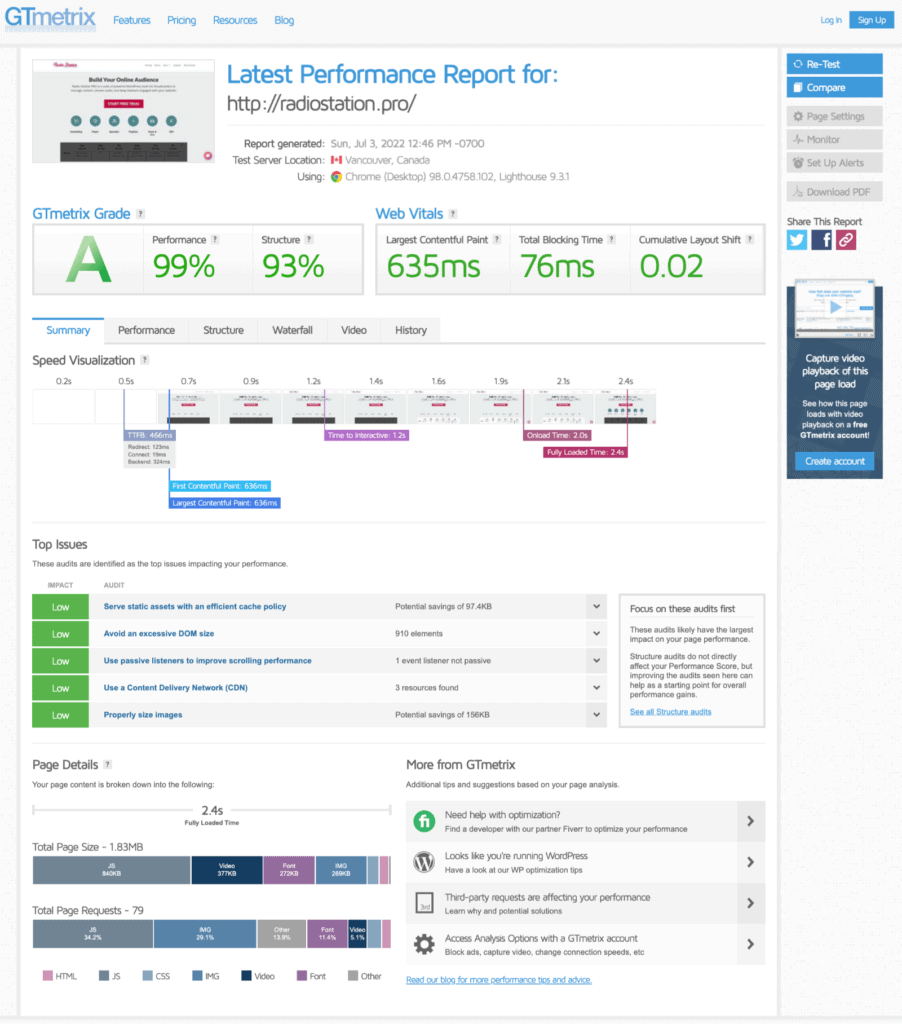
While Google shows us that we score 94 on desktop {left image) we score far lower (46) for mobile (right image). We’ll certainly need to address our mobile page speed and make some changes to fix it.

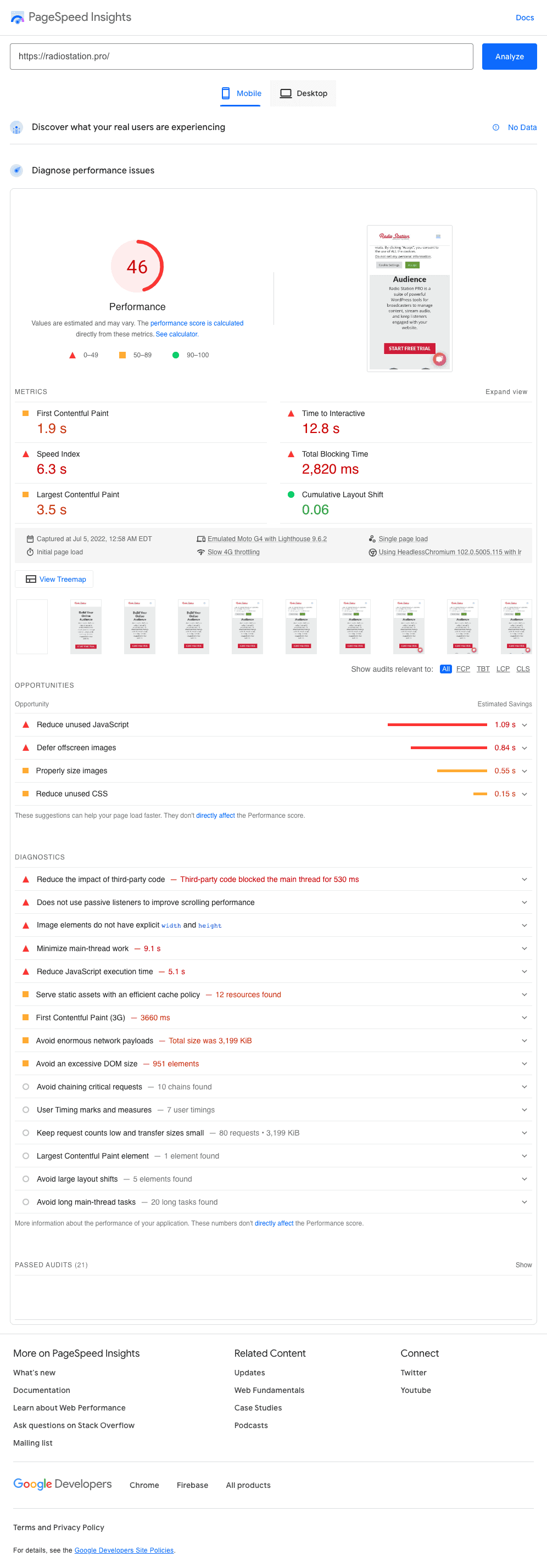
Now that you have these reports, you’re armed with the information you need to start to make the changes necessary to boost your ratings. Remember, ratings are measurements only. Google reserves the right to apply page rank to your site in whatever way their algorithms take into considerating all factors. Just because you score high doesn’t necessarily mean you’re going to outrank your competition, but it does mean that you should have a fighting chance because you took the steps to do so.
Common page speed optimizations
Here is a list of common page speed action items you’ll want to focus on. For the purpose of this post, we’re not going to show you how to use these tools when you can simply visit Tom’s Online Media Masters site, which is probably the most comprehensive resource on page speed optimization we’ve found on the web. it’s just good to have the list below to know where to start.
Image compression
You’ll want to compress all images using one of the many image compression plugins out there. The lighter your images, the faster they load. Try out ShortPixel.com, Imagify.com, or WP Smush among others. We use Short Pixel because it is integrated with Autoptimize. In addition to compressing images, these services can convert from png and jpg into modern formats like webp and avif. Click this link to view a recent article (September 2022) from All In One SEO on the 6 Best Image Optimization plugins.
Lazy Load
Images and videos, especially those embedded on your site from 3rd party services, can cause pages to load slower on mobile phones with connected to various cellular networks, which all have their issues. We’ll want to use the recent lazy load enhancement in WordPress core introduced in version 5.4 to load images once the user scrolls to the image on the page.
Many of the page speed plugins have a Lazy Load feature, but they are hierarchical and work if one doesn’t exist. If you’ve advanced to WordPress 5.4, you shouldn’t have to worry much about lazy load, but then there are video embeds from sites like YouTube, which call an API and take precious seconds to load video to your site’s pages. To Lazy Load YouTube videos, use a plugin like WP YouTube Lyte by the same developers of the Autoptimize plugin.
Minify CSS, HTML, and JavaScript
WordPress PHP pages contain a lot of extra whitespaces. Each space on the screen is an empty character that still has to render as the page loads. We want to minimize the white space because we don’t want to load unnecessary characters when there’s nothing there in the first place. Plugins like WP Rocket, W3 Total Cache, and Autoptimize collapse all the extra white space in your site’s pages with the click of a check box. We use Autoptimize because of the awesome support we get from Frank Gossens, the plugin’s developer, who has been nothing short of amazing.
Eliminate Render-blocking JavaScript
Render-blocking is when JavaScript disrupts the loading of above-the-folder content. We want to ASYNC or DEFER these scripts to minimize the impact they have on page speed. Autoptimize, in conjunction with its sister plugin, ASYNC, will help you load JavaScript asynchronously or defer it until after the page loads. This is trial and error and you have to see which works better for your site. You want to be careful here to test these theories on a DEV or STAGING site because you can take your site down or render some features inoperable. it’s trial and error to get the right mix.
Plugins like Speed Booster or Asset Cleanup allow you to dequeue CSS and JavaScript you don’t want loading on either the entire site, just the home page, or individual pages. They both have other useful optimization features, as well.
Caching
Today, many WordPress web hosts offer the ability to cache site static site pages – a snapshot of a page – so that it’s delivered to the user faster than having WordPress dynamically build it each time the page is called. There are page-level caches, object caches for common database queries, and browser caches that store images in your browser’s cache – certainly a lot of opportunities to cache content so it’s delivered faster to the end-user. Cache-control headers notify the browser as to when content is fresh and expire cached content after a set amount of time. You’ll want to check with your hosting provider to better understand how and what they cache. Sometimes, people use page speed optimization plugins that employ caching when they get caching from the host, so you’ll want to make sure if you use these types of plugins and define what service is going to cache your content.
CDN (content delivery network)
A content delivery network is a distributed network of servers around the world sitting at the edge of major metropolitan areas. They hold copies of cached pages and media files from hundreds of millions of websites, which can serve content to the closest local requestor, speeding up access to sites and delivering them far faster than ever before.
There are a number of CDN providers web hosting companies contract with that are built into the provider’s plan. However, you can use the free CDN service from Cloudflare. The company offers its CDN free with paid upgrades for services like a firewall or an optimization suite (which we haven’t analyzed yet) if you need that level of security or want to use Cloudflare’s tools for page speed optimization.
For example, WP Engine partnered with Max CDN, but the popular WordPress hosting provider is now switching to the Cloudflare network. While we have always used Cloudflare in tandem with WP Engine, our hosting provider, they now have a tighter integration, which means you may no longer need the Cloudflare plugin with WP Engine’s service. The plugin connects your site to Cloudflare to enlist the various services provided by the company to optimize your site. But with the new Cloudflare service integrated with WP Engine, that may no longer be necessary. We still connect to Cloudflare with the plugin, just to be on the safe side.
Optimize and pre-load fonts
Lots of themes and page builders use Google’s free font library, which hooks into the Google API to load fonts from Google servers. The call to the API and response can take time, which we want to avoid. While many page speed optimization plugins are now adapting to include a feature that downloads Google fonts and hosts them on the server, the free plugin, OMFG, can do this for you, as well. Note: Not only is this important for page speed optimization, it’s also a European Union GDPR issue. When a font is loaded into the browser, Google tracks the user’s IP address for analytics purposes. Downloading and serving Google fonts from the server eliminates IP tracking. Lastly, this also helps to solve “cumulative layout shift” issues resulting from assets that shift the page as it downloads. This can happen with fonts, images, videos, forms, buttons, and other assets as the pages render in the browser.
Localize Google Analytics and Tag Manager
Another issue we run into with Google and page speed is loading the Google Analytics and Tag Manager scripts. Again, because there’s an API call, the call and response time can slow down page load. We can resolve this by storing scripts on the server instead of on the page itself. Plugins like Speed Booster Pack and CAOS will take the analytics.js script and host the server side. The script will be updated automatically whenever Google makes a change so you don’t have to worry about the plugin needing to update the .js file.
Hosting
Your web host can be more of a problem than you think. If you’re working with cheap, shared hosting, your site is sitting in the same directory as other sites using server resources, which could also drag on performance if those sites need more resources than your own.
Benchmarking hosting plans side by side to measure performance is difficult, so most of us have to rely on the judgment of others who do this for a living and publish their findings on blogs or social media forums. Most small webcasters are not qualified system administrators and wouldn’t know the difference, so we have to rely on the work of others to know where we’re going to get the best bang for our buck.
Tom from Online Media Masters moved from Siteground to Cloudways and measured the performance in a side-by-side comparison. He writes about his finding on his blog, which you can read for yourself and make your own determination.
At Radio Station PRO and netmix®, we use WP Engine exclusively.
Cumulative Layout Shift: What is it and how do I fix it?
Cumulative Layout Shift is a metric that checks the stability of a page as it loads in the browser. CLS, as it’s commonly referred to, is measured by Google Page Speed Insights, as well as other common page speed metrics reporting tools. A poor CLS score can happen for a variety of reasons. Fonts can flash as the page loads. Ads, images, and embeds may not include width and height dimensions that tell the browser how much space to reserve. Dynamically injected content like animations may cause issues. And, actions waiting for a network response may be a factor, as well.
Your Google Page Speed Insights report will help you narrow down CLS issues. You can see our mobile score has issues but our desktop is very good.
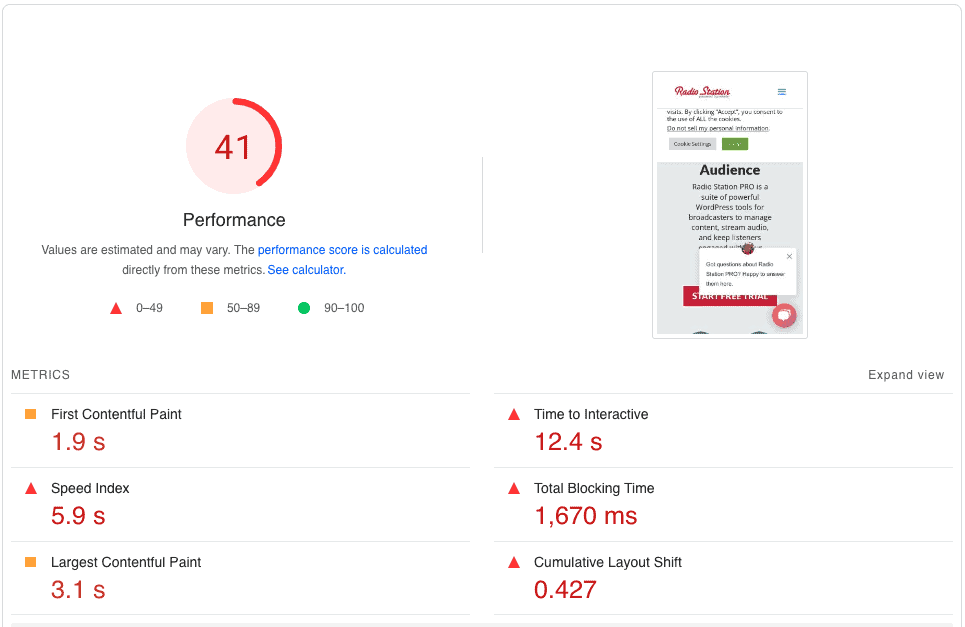
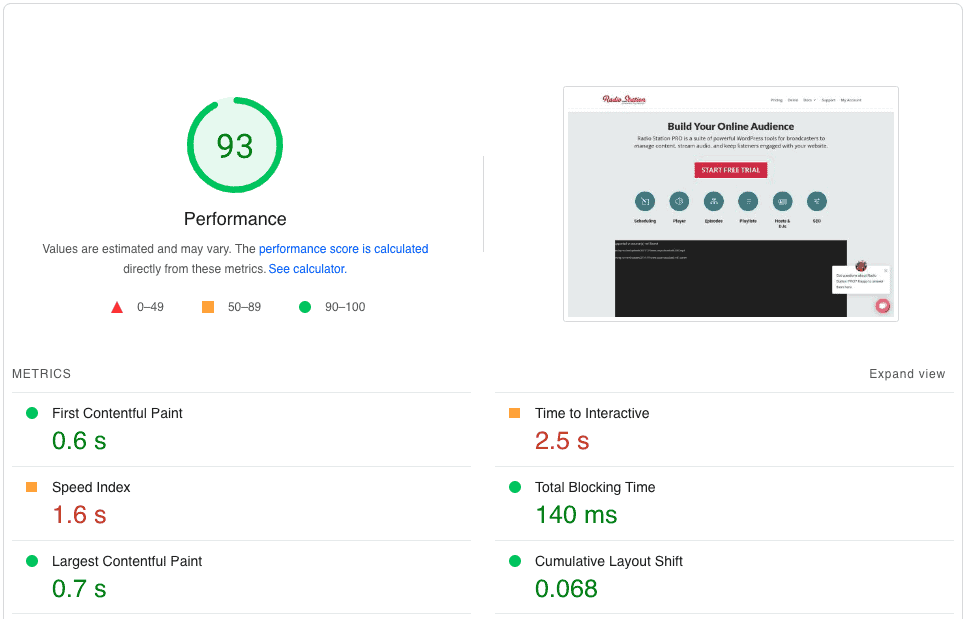
Cumulative Layout Shift Stats for RadioStation.pro from Google Page Speed Insights
You can use the Cumulative Layout Shift Debugger to better understand what issues are present. Watch the LOOM below to see how the debugger uncovered the layout shifts affecting our website.
While I could list all the methods to fix CLS issues on your site, I’ll defer to this post to give you a broad overview of CLS and some options to fix, and this post, which is specific to WordPress and Divi but contains information that can be used across the board.
WordPress SEO Plugins
WordPress certainly does make Radio Station SEO easier than it would be without all of the tools that exist today. WordPress has evolved from its humble beginnings as a blog platform to a full-fledged CMS with SEO in mind. From page titles and the ability to customize the “permalink” structure of the resulting URL to category and tag management, while also setting H1 through H6 headings, WordPress already includes built-in SEO tools. However, managing what Google crawls on your site needs the help of a third-party plugin, which when used properly can improve your site’s page rank.
For example, the free, open-source version of WordPress doesn’t include a core system to build a sitemap for submission to search engines. That responsibility is left to plugin developers who developed sitemap generators and includes JetPack, a plugin that is owned by Automattic, the parent company of WordPress.com.
In the early days of WordPress, website owners needed a tool to manage snippets and submit a sitemap to search engines. All in One SEO was the first plugin to bring various aspects of WordPress search engine optimization into one cohesive plugin.
While many SEO beginners flocked to its competitor Yoast because of its marketing strategy, All In One SEO remained the choice of SEO professionals. Since Awesome Motive acquired All in One SEO a few years back and rebuilt the plugin from the ground up, the new AIOSEO has expanded its feature set and rolled out a much-improved user experience. Its administration interface is top notch and it now includes features such as Breadcrumbs, Redirection, and Schama markup.
While the fomer owner of AIOSEO eschewed the “red light, green light” feature of Yoast that analyzes your page or post and generates an optimization score, which they believed impacted page speed, the new AIOSEO has an exceptional SEO analysis tool with a scoring system that helps beginners and professionals alike with recommendations for making improvements. We employ AIOSEO on this site and others in our netmix® network and recommend the plugin to our Radio Station and Radio Station PRO customers.
What does a WordPress SEO plugin actually do?
The primary reason to use a WordPress SEO plugin on your radio station’s WordPress site is for customizing and managing the page or post snippets that appear on a search engine results page (SERP). Generally, a search engine will pull the page title and a paragraph of text it deems relevant to the page or post from the first paragraph is finds. However, this paragraph may not accurately describe, in the search result snippet, the content of the page or what you want the reader to know. SEO plugins give you the ability to show Google something different in the hopes that the search engine will pull text you define that accurately describes the content of the page.
SEO plugins like All in One SEO give us a snippet editor to customize the meta title and meta description in the hopes that Google will pick it up and use that instead of what it grabs from the top of your page. It leads to better SEO because the title and description are optimized with keywords for Google to read and display but are not displayed on the site itself.
Let’s walk through an example of how Google pulls the snippet for your pages and posts. Here is a screenshot of the top of our home page.
We can see that the text reads:
Build Your Online Audience: Radio Station PRO is a suite of powerful WordPress tools for broadcasters to manage content, stream audio, and keep listeners engaged with your website.

Google should pull this text, and in many cases it does. However, Google can determine what’s a better reference point, pulling the text from the page or pulling text from the AIOSEO snippet editor.
Image 1 below is exemplifies the AIOSEO snippet editor at work on our Radio Station PRO home page. Take note of how the wording in the Meta Description field is an exact match to what Google includes in the snippet in the following image. Image 2 is the actual matching Google snippet appearing in the results.
Image 1: AIOSEO Snippet Editor
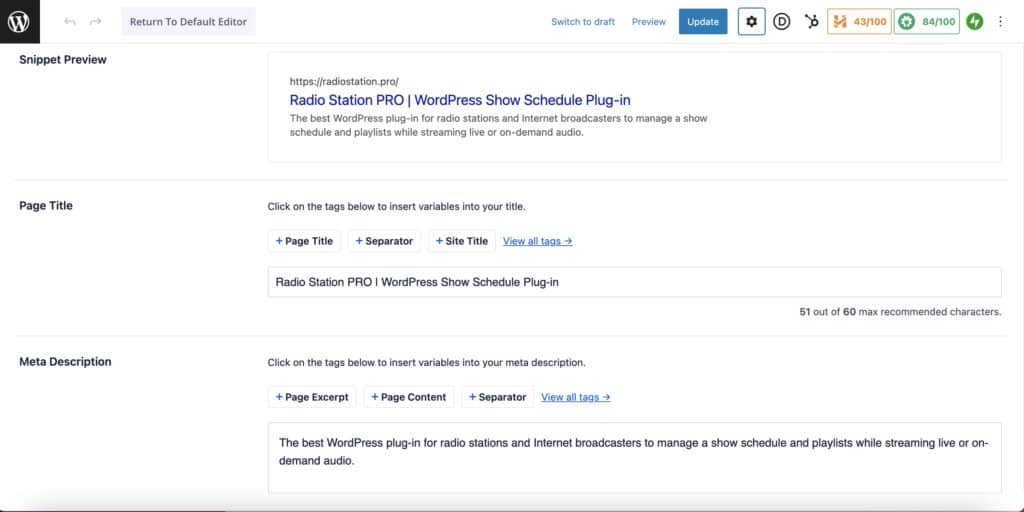
Image 2: Actual Google Snippet

We can see how powerful the AIOSEO snippet editor is. The meta description provides an opportunity for keywords and for marketing, so it’s critical we have a tool to manage it.
In the example, we can also see that the Page Title and Meta Description fields are filled out appropriately and do not go over the character count. Note the character count is an approximation. Google uses the width of a snippet and will create ellipses if the content is too long, which then cuts off important keywords in the snippet. SEO plugins can approximate the width of a snippet only by using the character count method because widths vary using both upper case and lower case letters vary. An upper case “L” is wider than a lower case “l.”
It’s important to note that Google does not have to adopt the custom meta title or description you crafted. More often than not, Google will display your custom meta title and meta description, but there are times we’ve seen it ignore them. If you’re just updating them for the first time, it could take a few days to see the new changes reflected in the search result.
There are many other aspects of the All In One SEO Pro plugin that you might utilize on your station. For example, let’s say you’re a new station. You can generate and submit a news sitemap for news posts that get ingested into Google Newsstand. You’ll need to submit a request through the Google Publisher Center to be included. If accepted, your News posts will be ingested and appear in the Newsstand along with other news organizations.
You can also utilize All in One SEOs built-in, Robots.txt editor, where you can add custom rules to allow or disallow search engines from crawling your content on your site. Your sitemap provides a constant connection with Google and other search engines you submit to. Robots.txt helps you fine-tune what you want to appear to make sure you’re in full control of what search engines can display.
All in One SEO PRO now has a Redirection Manager. When a post or page title is changed or a post or page is removed, it takes some time for Google to see and update that change. Redirects help you redirect the changed content to live, fresh content, so that a user never sees a 404 Not Found page on your site.
The Redirection Manager is a critically important tool to help Google and other search engines understand what happened to a piece of content and redirect web searchers to that content until the search engine updates itself with the new link based on recrawling the site to see what’s changed.
If you don’t have All in One SEO or another SEO plugin with a Redirection Manager, you can always use the popular Redirection plugin from John Godley. With over 2M+ active installs, it’s been the leading Redirection Manager plugin for WordPress for many years. While we use the AIOSEO plugin here at Radio Station PRO, some of our sites still use Redirection simply because it’s that good and there’s no reason to switch. Of course, you can always import/export your established rules from one to the other, if needed.
Lastly, the Social Meta module included in All in One SEO FREE and PRO (PRO has additional features) gives you the tools to manage how social shares of your content appear on social media networks like Facebook, Twitter, and LinkedIn when someone shares your content on one of the networks. it is an incredibly powerful tool. Some setup is required, but once you’ve established a rhythm, it’s a piece of cake to use.
You can customize the post Title and post Description orchoose a custom image, the Featured Image, or define whether the first available image in a post should be included in the share on a per post/page or sitewide basis. You can set whether the post uses the same settings for both Facebook (and other OpenGraph participating sites) andTwitter, or you can craft different content to appear on their respective platforms.
One not-so-obvious aspect of managing social meta is clearing the cache kept by each social network, so if you change the content of your social meta panel, you’ll want to visit the “debugger” for Facebook, Twitter, and LinkedIn to clear what’s been stored. If it’s a new post or page, Facebook will tell you that it’s never been crawled before, but when you click to clear the cache, it will populate the relevant Title, Description, and Featured Image.
Debuggers
There are many other excellent features of All in One SEO and we are confident it is the top SEO plugin for WordPress.
The Final Piece: Radio Station Schema Markup
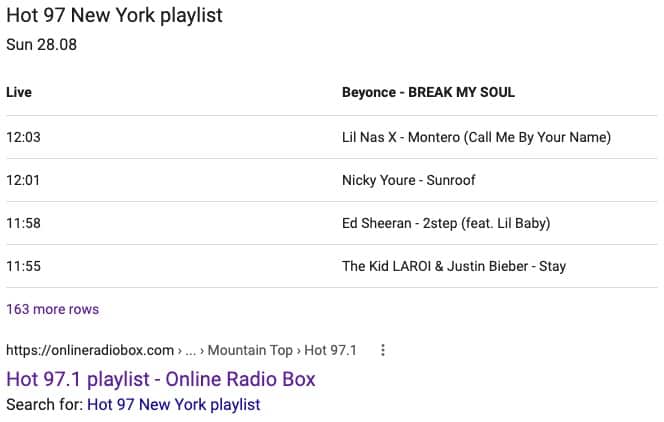
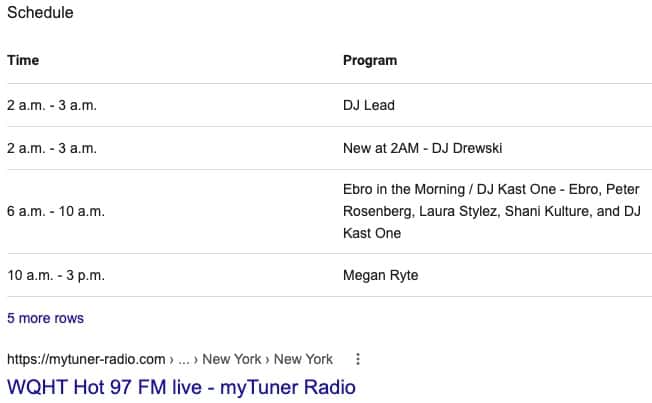
Many Radio station aggregators like Online Radio Box and MyTuner-Radio apply schema markup to Radio station data ingested from a feed or the source website to help search engines like Google make sense of and display music playlists, music albums, and music recordings (single songs) in structured layouts designed to display this information in a logical manner on a web page. The primary Schema Type is Radio Station. There are a number of other useful Schema Types you can apply to data on your Radio station’s WordPress website.
At the time of this writing, we don’t know of any WordPress plugins applying Radio-specific Schema markup. It’s in the works for Radio Station PRO or you can use the Custom Schema tab in All in One SEO to generate Schema markup in JSON_LD format for a page or post.
To generate the JSON-LD to use with AIOSEO, you’re going to need to Google “schema markup generator” and then test a few to see if you can return the Radio Station Type. Usually, it’s a child of Local Business.
Here’s a useful Schmea markup generator we found with the Radio Station Schema type, as well as a few others in that same family. Simply type “radio” in the search field and it will return all radio-specific Schema types. Each type has a series of fields and selectors you’ll need to enter data into to get the JSON-LD output that you will then add to individual pages and posts.
This one also includes Events but does not include Schedules, which we found odd. It also does not include Podcast Schema Types either. There are many other Schema markup generators, so you may have to look around to find the one that does the job.
Note that you don’t have to actually wrap the data on the page itself with Schema markup. You add the JSON-LD generated by the Schema markup generator to a custom field in AIOSEO (or another SEO plugin you use that supports custom Schema JSON-LD) and search engines will pick that up and display the included data on a search engine results page.
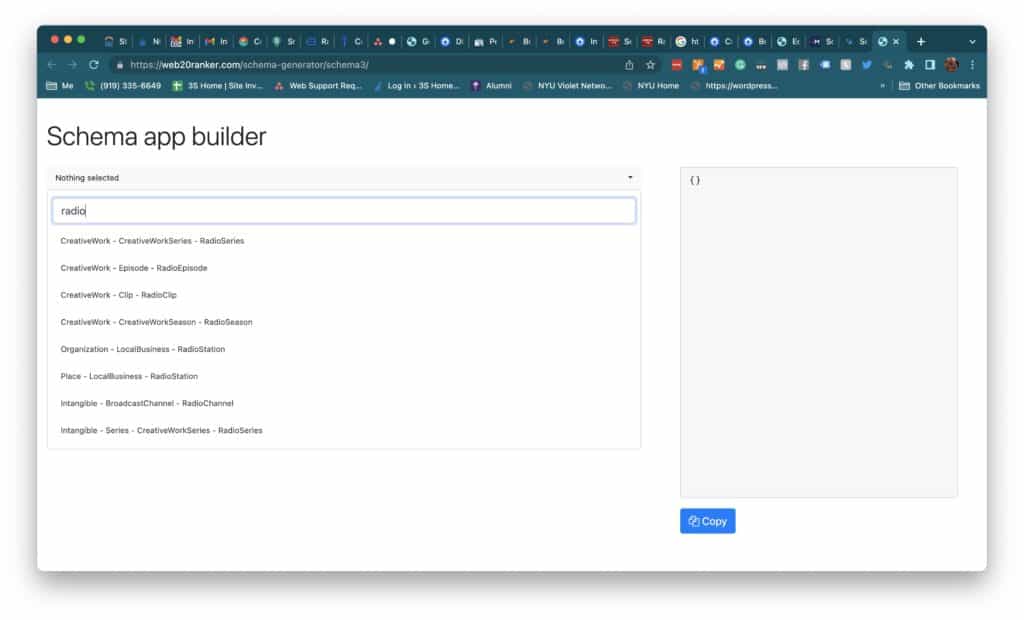
List of useful Radio Station SEO Schema markup
Here are a few Radio Station Schema Markup types, as well as others that are useful to Radio stations.
To better understand what markup exists, start with the primary Radio Station Schema Type: https://schema.org/RadioStation.
- RadioBroadcastService
- RadioEpisode
- RadioClip
- MusicEvent
- Music Recording
- Music Album
- FMRadioChannel
- CallSign
- BroadcastService
- BroadcastEvent
- BroadcastChannel
- EventSeries
- PodcastEpisode
- PodcastSeries
- PodcastSeason
- AudioObject
Let’s Wrap!
SEO is not a set it and forget it process. For some, it’s now a lucrative, full-time career. Today, SEO is 80% knowledge and application and 20% developer-centric, because all the tools exist for you to use plugins to manage your on-page SEO and your page speed SEO. I hope this post provided you with the knowledge and resources to get you started mastering your own Radio Station SEO.
If you have any questions or comments, please do leave them in our comment section below. All comments are moderated.
If you think this post on Radio Station SEO created value for you, then please do share it with your social networks and amongst your peers and colleagues.
If you need SEO assistance, we also consult on SEO strategy and can help you formulate and activate your SEO campaign. Contact us to discuss!
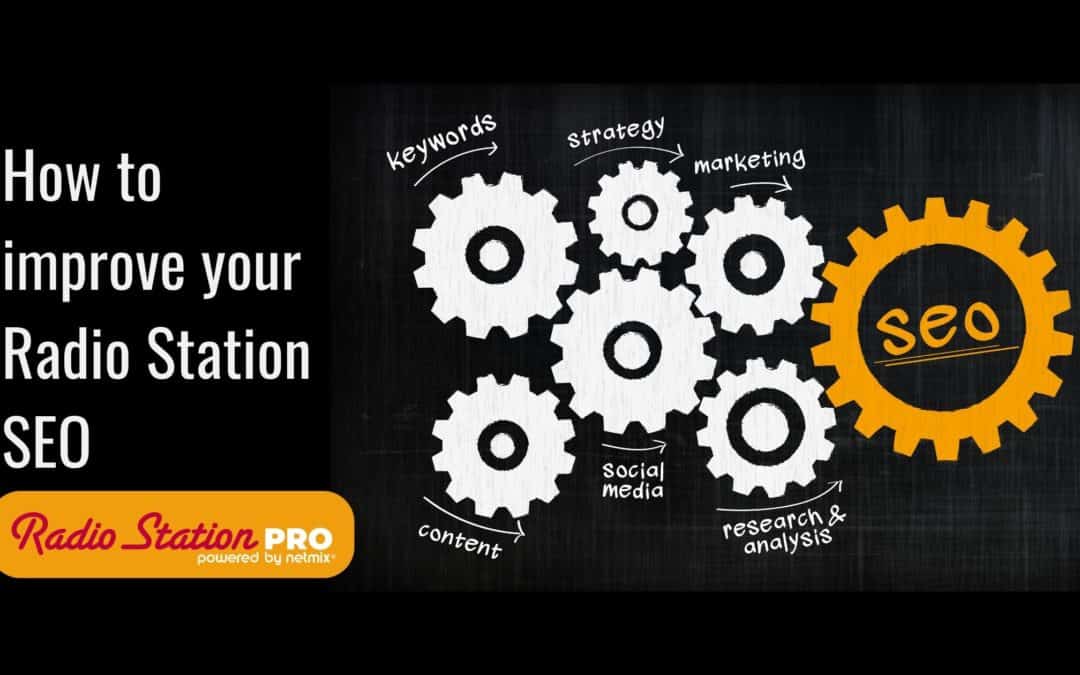




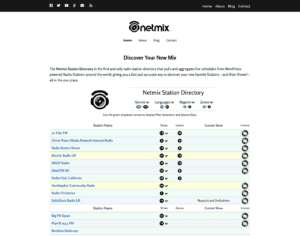
You must be logged in to post a comment.